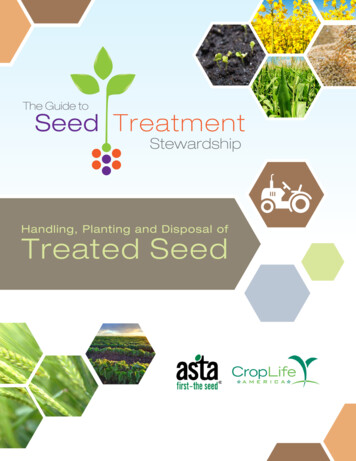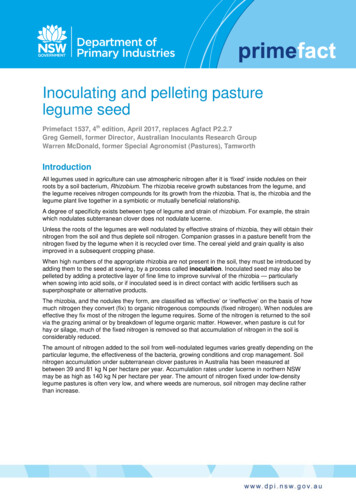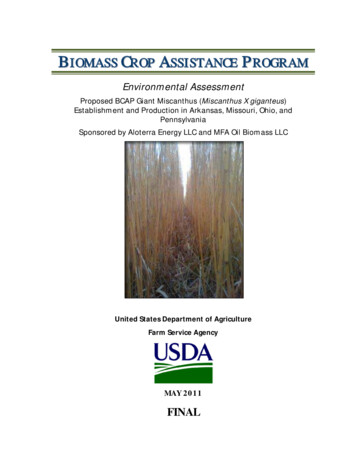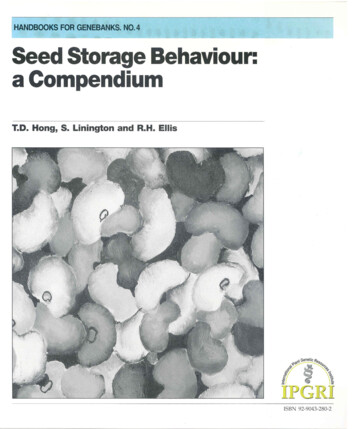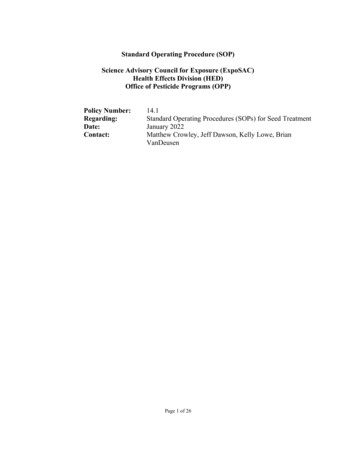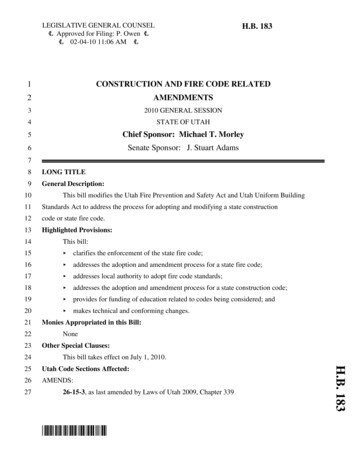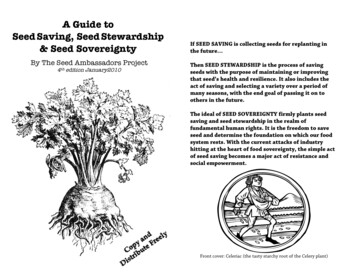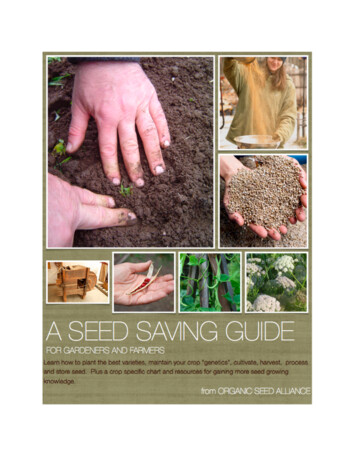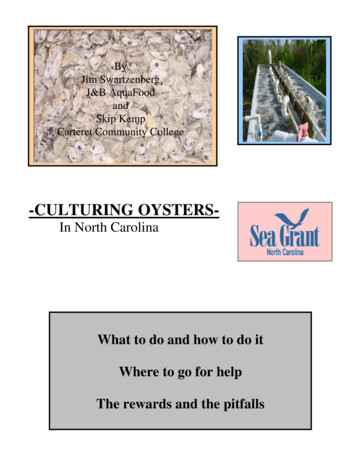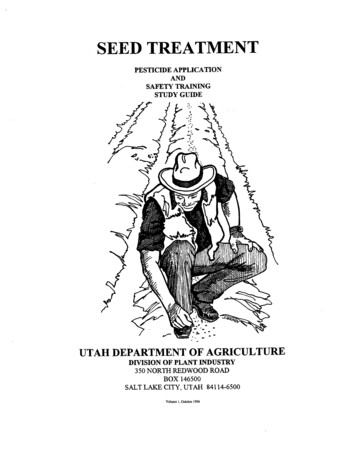
Transcription
SEED TREATMENT STUDY GUIDEThe educational material in this study guide is practical information to prepare you to meet thewritten test requirements. It doesn’t include all the things you need to know about your pestcontrol profession. It will, however, help you prepare for your examinations.Contributors include the Utah Department of Agriculture and Utah State University ExtensionService. This study guide is based on a similar one published by the Colorado Department ofAgriculture. Materials were prepared by Colorado State University Extension Service. Othercontributors include: University Extension Service personnel of California, Kansas, New York,Oregon, Pacific Northwest, Pennsylvania and Wyoming; U.S. Department of Agriculture - ForestService; the U.S. Environmental Protection Agency (EPA), Office of Pesticide Programs; and theDepartment of Interior - Bureau of Reclamation and Metro Pest Management.The information and recommendations contained in this study guide are based on data believed tobe correct. However, no endorsement, guarantee or warranty of any kind, expressed or implied, ismade with respect to the information contained herein.Additional topics that may be covered in your examinations include First Aid, Personal ProtectiveEquipment (PPE), Protecting the Environment, Pesticide Movement, Groundwater, EndangeredSpecies, Application Methods and Equipment, Equipment Calibration, Insecticide Use,Application, Area Measurements, and Weights and Measures. Information on these topics can befound in the following books:1. National Pesticide Applicator Certification Core Manual, Published by the NationalAssociation of State Departments of Agriculture Research Foundation.2. The Workers Protection Standard for Agricultural Pesticides – How to Comply:What Employers Need to Know. U.S. EPA, Revised September 2005, PublicationEPA/735-B-05-002.These books can be obtained from the Utah Department of Agriculture or Utah State UniversityExtension Service. Please contact your local Utah Department of Agriculture ComplianceSpecialists or Utah State University extension agent.
TABLE OF CONTENTSINTRODUCTION . . . . . . . . . . . . . . . . . . . . . . . . . . . . . . . . . . . . . . . . . . . . . . . . . . . . . . . . . . . . 1DISEASE PESTS IN SEED . . . . . . . . . . . . . . . . . . . . . . . . . . . . . . . . . . . . . . . . . . . . . . . . . . . . . 1COMMONLY TREATED SEED DISEASES . . . . . . . . . . . . . . . . . . . . . . . . . . . . . . . . . . . . . . . 1INSECT PESTS IN SEED . . . . . . . . . . . . . . . . . . . . . . . . . . . . . . . . . . . . . . . . . . . . . . . . . . . . . . 2SEED-TREATMENT PEST CONTROL . . . . . . . . . . . . . . . . . . . . . . . . . . . . . . . . . . . . . . . . . . . 4STORAGE INSECTS AND FUNGI . . . . . . . . . . . . . . . . . . . . . . . . . . . . . . . . . . . . . . . . . . . . . . 5SOIL INSECTS AND FUNGI . . . . . . . . . . . . . . . . . . . . . . . . . . . . . . . . . . . . . . . . . . . . . . . . . . . 5APPLICATION . . . . . . . . . . . . . . . . . . . . . . . . . . . . . . . . . . . . . . . . . . . . . . . . . . . . . . . . . . . . . . 6PESTICIDE LABELS . . . . . . . . . . . . . . . . . . . . . . . . . . . . . . . . . . . . . . . . . . . . . . . . . . . . . . . . . 7SAFETY IN TREATING . . . . . . . . . . . . . . . . . . . . . . . . . . . . . . . . . . . . . . . . . . . . . . . . . . . . . . . 8APPLICATION EQUIPMENT . . . . . . . . . . . . . . . . . . . . . . . . . . . . . . . . . . . . . . . . . . . . . . . . . . 9THREATENED AND ENDANGERED SPECIES . . . . . . . . . . . . . . . . . . . . . . . . . . . . . . . . . . 11WORKER PROTECTION STANDARDS . . . . . . . . . . . . . . . . . . . . . . . . . . . . . . . . . . . . . . . . 11GROUNDWATER CONTAMINATION BY PESTICIDES . . . . . . . . . . . . . . . . . . . . . . . . . . . 12
- Curvularia- EpicoccumINTRODUCTIONSeed rots and seedling blights in soil:Seed treatment referred to in this study guide is theapplication to seed of any substance or mixture ofsubstances intended to control diseases and insects. Itincludes control both while the seed is in storage andwhen it’s in the soil after planting.- Diplodia- Pythium- Fusarium- Rhizoctonia- HelminthosporiumA person treating seed should not only know the kinds ofseeds to be treated but also the diseases and insects tobe controlled. They should also know which chemicalproducts are effective and approved, and the chemicalproducts their equipment can apply correctly.COMMONLY TREATEDSEED DISEASESSeed treatment with chemicals to control seed-borne andsoil pests of small grains is a long-established, successfulfarming practice. Smuts and seedling-blight diseases canbe reduced or eliminated by using effective fungicides.Specific information should be obtained from the localextension agent, the equipment manufacturer, or theformulator of the pesticides.WHEAT, OATS, BARLEY ANDSORGHUMDISEASE PESTS IN SEEDSeed rots and seedling blights are caused by several seedand soil fungi. They attack germinating seeds andseedlings, especially if the seed is of poor quality andgermination conditions are not ideal. Seed treatmentprotects young seedlings from attack and results instronger plants and a more even stand.FUNGI AND BACTERIANone of these disease organisms, except some smuts,need to be identified by applicators because there aresome seed-surface disinfectant fungicides that control allseed rot and seedling-blight fungi and bacteria. Controlof some smuts requires a specific fungicide thatpenetrates the seed as it begins to germinate and killsinfection inside the seed, such as the loose smut of wheatand the brown loose smut of barley.Bunt (covered or stinking smut) of wheat and barley andblack loose smut of barley are carried only on the seedsurface. Control requires a seed-treatment seed-surfacedisinfectant.In barley stripe on the leaves, fungi are controlled by aspecific seed treatment. Use only materials registeredfor control of the specific diseases. If smut or barleystripe is present in a field, the seed will require treatmentto produce acceptable smut- or stripe-free grain in thenext crop.Loose smut of wheat and bran loose smuts of barleyinfect the embryo and require systemic seed treatments(carboxin) for control. Barley loose smuts are very hardto detect, so systemic-fungicide seed treatment isadvisable if loose smut was prevalent in the seed field.Barley-stripe fungus is also seed-borne and is controlledmore effectively by systemic fungicides.The following disease organisms may be found on or inseed.These problems make it more important to treat barleyseed with systemic fungicide than any other small grains.Control requires a seed-treatment disinfectant thatpenetrates sprouting germs.Stored-grain pests and smuts:- Alternaria- Aspergillus- Bacteria- Cladosporium- Tilletia(smut)- Ustilago(smut)- Mucor- Penicillium- Rhizopus- Sphaceloteca(smut)BARLEY SMUT1
Covered and black smut require a seed-treatmentfungicide that penetrates into all cracks and crevices ofthe seed. Brown smut requires one that penetrates anddisinfects sprouting germs.BARLEY-STRIPE DISEASEThis is controlled by a seed-treatment fungicide thatpenetrates into all cracks and crevices of the kernels.Oats are affected by two smuts. Both are carried on theseed surface, but some spores may lodge under the hulls,making control difficult. With resistance in most currentoat varieties, the non-systemic, surface-acting fungicideswill give adequate control. Systemic, surface actingfungicides will give adequate control. Systemic materials(carboxin) may be advisable where better control isdesired, such as in certified seed where smut wasobserved in the seed field.HEAD SMUT OF SORGHUMThis isn’t completely controlled by seed treatment, sincethe fungus lives in the soil and can invade seedlingsbelow ground. Spores can be carried by the wind.INSECT PESTS IN SEEDSOIL INSECTSInsects that eat seed in the soil can only be controlled bytreating the soil with a proper insecticide or treating theseed. Treating the seed is less expensive and puts lessOAT SMUTS L to R:Healthy head, loose smut, healthy head, coveredsmut. Controlled by a seed-treatment fungicide thatpenetrates into all cracks and crevices of the kernels.SORGHUM-KERNEL SMUTThis smut is controlled by treating the surface of seeds.A smutted kernel has dark brown spores completelythroughout, in contrast to saprophyte molds, which attackthe surface of kernels in the field. These saprophytesdon’t reach all the way through the large kernels, leavingkernels white inside.Seed corn beetlechemical in the soil. The following are some of thecommon soil insects.SEED-CORN BEETLES feed on corn or sorghum inthe ground. A yellowish-brown beetle with black wingcovers, it measures five-sixteenths inch in length, or alittle less. The head is black, while antennae and legs arelight brown. There are shallow furrows on the wingcovers.SORGHUM KERNEL SMUTThis smut controlled by treating surface of the seeds.A smutted kernel has dark brown spores completelythrough in contrast to saprophyte molds that attacksurface of kernels in the field. These saprophytesdon’t reach all the way through thye large kernelsleaving kernels white inside.SEED-CORN MAGGOT is a small black or grayishblack fly one-eighth to one-fifth inch long. The pale oryellowish-white maggots of this fly attack germinatingseeds and sprouts in cold, wet seasons.2
KAFIR OR THIEF ANT is a tiny, reddish-brown antthat attacks seed of sorghum or corn, resulting in a weak,sickly sprout. The starchy part of the kernel is eaten outand scattered through the ground.Saw-toothed grain beetleDERMESTID BEETLES, LARGE CABINETBEETLE, AND OTHER SPECIES are scavengerson animal matter such as hides, furs and wool. They willalso feed on stored grain and grain products. The larvaeand pupae can survive rigorous environmental conditions.Under such conditions, the life cycle may be as long astwo or three years.Kafir or Thief antTRUE WIREWORM larvae are similar to falsewireworm in that they eat seeds and young plants. Theyare usually found in moist soil, unlike false wireworm.Larger cabinet beetleGRANARY AND RICE WEEVILS are the mostTrue wirewormscommon insects found infesting stored grain. Femaleslay their eggs in a hole cut in the intact kernel. Larvaehatch and feed inside the kernel, hollowing it out as theydevelop. Adults feed on whole or broken grain. A lifecycle requires about four weeks for completion. Riceweevil adults fly. Granary weevil adults cannot fly.STORAGE INSECTSStorage insects are those that damage seed when storedin bulk or in bags. The following are examples withdescriptions. Some others are pea-bean weevils, andspider beetles.SAW-TOOTHED GRAIN BEETLE is a small,slender brown beetle. There are six saw-toothedprojections on the thorax, from which this pest gets itsname. This beetle attacks a variety of flour, meal, fruit,candy and grains. Eggs are laid in the food. The lifecycle takes three to four weeks for completion.Rice weevilCONFUSED FLOUR BEETLE AND REDFLOUR BEETLE larvae and adults prefer to feed on3
cracked grains, flour, and other cereal products. Eggsare laid loosely in the food material, and developmenttakes place in the food. The life cycle takes about sixweeks to complete.whole grain, flour or meal. Both adults and larvae cansurvive without food for long periods of time, hidden inthe woodwork of bins. When new grain is put in the bin,the insects then move into the grain. The life cycle mayvary from a few months to two years, depending onconditions.Red flour beetleLESSER GRAIN BORER larvae are internalCadellefeeders on grain kernels. Eggs are laid outside thekernels; larvae hatch and bore into the kernels, hollowingthem out as they grow. Adults can feed on whole andcracked grain. The life cycle takes three to four weeksto complete.FLAT GRAIN BEETLE is one of the smallest graininfesting beetles. Since it cannot feed on sound grain, itusually follows the attack of other insects. Underfavorable conditions, the life cycle may require aboutfive weeks.Lesser grain borerINDIAN-MEAL MOTH larvae feed on grains, grainproducts, nuts, dried fruit, and other food. The adults arecolored a characteristic coppery-brown on the wings.Eggs are laid singly or in groups on the food. The lifecycle takes from six to eight weeks to complete.Flat grain beetleANGOUMOIS GRAIN MOTH LARVAE areinternal feeders on grain kernels. Females lay their eggson the outside of the kernel, then the larvae bore in anddevelop inside the kernels. Beside the feeding damage,adults cover the inside of the bin and the surface of thegrain with webbing.Indian-meal mothCADELLE is one of the largest stored-grain insects. Itis primarily a wood-boring insect but will also feed onAngoumois grain moth4
Some of these stored grain insects are also KITCHENPESTS.Most insects start to feed in sorted seed whentemperatures are above 50 degrees F. and humidity isabove 12 percent. However, some seed processors drythe seed to as low as eight percent. Since moisturecontent might increase in storage, it’s a good practice toapply an insecticide. Low-level, non-hazardous materialsare used.The saw-toothed grain beetle, red flour beetle, largercabinet beetle, and Indian-meal moth develop in flour,cake mixes, corn meal, breakfast foods, and similarproducts. The Angoumois grain moth infests popcorn.SEED-TREATMENT PESTCONTROLAn insecticide that becomes non-toxic is usually appliedso that any leftover seed can eventually be used for foodand feed. Other insecticides are applied near plantingtime to some seeds to keep soil insects from eating theseed. No fungicides are registered by EPA for control offungi in stored seed.Disease- and insect-control seed treatments function infour ways, depending on the nature and purpose of thetreatment.1. SEED-SURFACE DlSINFECTION -- Completecovering of the seed with a chemical that kills thespores and other forms of pathogenic organisms onthe surface of the seed. Example: Killing stinkingsmut spores or damping-off fungi that are on theseed.SOIL INSECTS AND FUNGISeed treatment with a pesticide is necessary to controlsome diseases and insects in the soil that are notcontrolled by resistant varieties or by biological, cultural,physical or sanitary means. It is a preventative methodand is recommended on kinds of seeds and in situationswhere research and experience in past years has shownit to be practical.2. SEED PROTECTION -- When a chemical on theseed protects the seed and young seedlings frompathogenic organisms or insects in the soil. Example:Control of seed-corn beetle or seed-rot anddamping-off organisms.A pest may be a problem over the entire state, or it maybe a problem in only some areas within a state. It maynot be necessary to treat for each given problem in alllocalities. For example, some extension entomologistsdon’t recommend treating wheat seed every year withan insecticide for soil insects. They know, from surveys,the areas where there are enough false wirewormbeetles to produce sufficient larvae and where the soil isdry enough to cause a problem. The Extension Servicecan notify growers whether or not to treat; however, truewireworm population distributions are not known andmay require treatment every year in nearly everylocation where seed is planted.3. SEED DISINFECTION -- Putting a chemical onthe seed that penetrates into the seed, killing internalfungus growth or insects, besides killing organismson the surface of the seeds. Example: Killing loosesmut fungus inside wheat seed or bean weevilsinside the seed.4. SYSTEMIC ACTION -- When a chemical on theseed penetrates the seed and extends into the plantas it grows, repelling or killing certain types of fungior insects or preventing their feeding. Example: Asystematic wheat-seed-treatment fungicide tocontrol loose smut on wheat.In contrast, damage to wheat seed from fungi on theseed and in the soil can’t be predicted, and there is areduction in seedling emergence of about ten percent ormore in nearly all years when the seed isn’t treated.Also, microscopic bunts or stinking-smut spores may beSTORAGE INSECTS ANDFUNGI5
on the seed without being seen. Since yields areincreased by one to three bushels per acre from seed-rotand seedling-blight control, and because the cost forproper seed treatment is relatively inexpensive, it’srecommended as a routine practice for each wheat crop.The minimum effective rates of many fungicides foradequate disease control in wheat have been fairly wellestablished. The rates of active ingredients for adequatecontrol under moderate disease pressures are generalguidelines. This will vary some with disease pressurefrom the weather and host susceptibility, but rates lowerthan these won’t give satisfactory control in severesituations.Likewise, stands of plants are often doubled and plantsare more vigorous when sorghum seed is treated with afungicide. This has produced, on the average, at least tenbushels per acre more grain and 33 percent more forage.Entomologists recommend that all sorghum seed betreated with an insecticide just before planting to preventseed- corn beetles, wireworms, or thief ants from eatingplanted seed. This problem isn’t as easy to predict asfalse wireworm damage to wheat. The cost is only a fewcents per acre, so it’s recommended that all sorghumseed be treated with both a fungicide and an insecticide.Minimum rates of commonfungicides for adequate control.seed-treatmentRate in oz./bu. of active Seed treatment to prevent seed rots and seedling blightincreases the yields of barley and oats an average of oneto three bushels per acre and corn by seven bushels peracre. There would be large losses in vegetables andflowers from seed and soul fungi and insects withoutseed treatment. Less than half of the varieties of cerealgrain used today are highly resistant to smuts. Seedtreatment is necessary to keep these diseases at a nondestructive level.Stand Increase0.50.51.00.5Bunt Loose Smut1.51.01.00.20.41.00.3Blanks mean either insufficient testing, not effective, ornot labeled.The amount of active ingredient per bushel of seedtreatment chemical can be calculated as follows forcomparing rates:APPLICATIONMix the seed-treatment chemicals with seed thoroughlyso every kernel is treated. None of the chemicals nowapproved are very volatile, so thorough mixing isespecially important. Custom treaters should give betterresults than farm applications, especially if seed iscleaned and treated. However, drill-box applications aresatisfactory if done carefully. Rates in the table are thosegiven on labels and are usually at the bare minimum to beeffective.1. If rates on labels are in ounces per bushel; activeingredients in oz./bu. can be calculated.No really new chemicals have come into small-grainseed treatment usage for ten years. The "new" labels aredifferent combinations and rates. Many companies havereduced label rates to be competitive, and this hasresulted in poor control where disease conditions aremoderate to severe.0.75 X 0.67 0.5 oz./bu. active captan.Multiply:% active ingredient X oz./bu. of chemical oz. ofactive ingredient/bu.Example: Captan 75% at 0.67 oz./bu. on wheat.2. If rates on the label are in ounces per hundredweight, oz./bu. active ingredients can be calculated.Multiply:% active ingredients X oz/cwt X weight of 1 bu. in pounds*6
Corn seed can be treated to protect against storageinsects. It should also be treated with a fungicide toprotect from seed rots and seedling blight of the soil. Aninsecticide can be applied to the soil to protect againstseed-eating insects.100 oz. active ingredient/bu.Example; Vitavax 25 DB at 4.0 oz./cwt. on wheat.0.25 X 4.0 X 60 0.6 oz. carboxin/bu.100Sugar BeetsBoth insecticides and fungicides are applied tovegetables and seeds to control storage insects and tocontrol seed rots and seedling blights in the soil.* Weights in lb./bu.: wheat, 60; barley, 48; oats, 32.Most fluid or flowable seed treatments are heavier thanwater. Pesticide liquids are a little heavier than water, soliquid fluid-ounces will weigh more than an ounce byweight. Therefore, to be more precise, this weightdifference must be considered, but this difference usuallywon’t be more than ten to 15 percent.Sometimes tomato, crucifer, and eggplant seeds arehot-water-soak-treated to remove certain bacteria andfungus agents.CompatibilityMost fungicides and insecticides registered for seedtreatment are compatible when mixed. One shouldconsult the label on each product for such information. Asmall slurry mixture of the materials should be made totest compatibility before the actual mixing and treatingoperation begins.Fungicides are less toxic than the "old mercuries," butthey are still poisonous and should be handled with dueprecautions. DO NOT FEED TREATED SEED TOLIVESTOCK. DO NOT MIX TREATED SEEDWITH MARKET GRAIN.PESTICIDE LABELSDon’t buy more than you will use. If you have someseed left over, keep it to plant next year.Before using any pesticide, study and analyze theinformation on the label. The label contains detailedinformation about the product, including:SorghumSeed-treatment fungicides are available that effectivelycontrol kernel smut, seed rot, and seedling blight ofsorghum. The fungus that causes head smut of sorghumisn’t controlled by seed treatment, as it infects theseedling above the seed.l. Active ingredients2. Inert ingredients3. Warning statements, such as “Danger -- Keep Outof Reach of Children” or “Poison -- Handle withCare”4. Antidotes5. Type of seed and treatment rate6. Kinds of pests controlled7. Care in handling and use of treated seed8. Disclaimer of warranty clause9. Mixing instructions10. Compatibility remarksFungicide seed treatment has increased the yield ofsorghum grain an average of more than ten bushels peracre and forage by more than 30 percent by controllingseed rots and seedling blights. A proper insecticideshould be on the seed during storage. An insecticide andfungicide which are effective against soil insects shouldbe applied before planting.CornThe smut of corn isn’t controlled by seed treatment,because the spores are blown from the soil to any part ofthe plant and infect at a puncture or injury site.7
to prevent their use by man or as feed for animals. Thisregulation is in Section 408 of the Federal Food, Drugand Cosmetic Act.Labeling Treated SeedThere are federal and state seed laws for labelingtreated seed. Information required to be shown on thelabel includes:Most seed-treatment pesticides now come from themanufacturer with the dye or color added as aconvenience to the operator. However, some seedprocessors prefer to add additional dye with thepesticides at their plants so that the desired color isobtained. Dyes approved by EPA cause no apparentinjury to seed germination or danger to personnelprocessing or using the seed.1. A word or statement in no smaller than eight-pointtype indicating that the seed has been treated.2. The commonly accepted, chemical or abbreviatedchemical (generic) name of the applied substanceand rate of application.3. Seed treated with a restricted-use toxic substancewill be labeled to show a statement such as "poisontreated" in red. In addition, the label will show a skulland crossbones.Carriers, Binders and StickersThese materials are listed on the label as inertingredients. There is no requirement that the name ofthese materials be given. They are selected by themanufacturer, approved by the Environmental ProtectionAgency (EPA), usually neutral in pH, and nontoxic tohumans, and they cause no apparent damage to thegermination of the seed. They are added to increase theadherence of the pesticide to the seed, prevent dustingoff, and/or cut down the dusty conditions in theprocessing plant.Sample label for restricted-use, highly toxicsubstances:THIS SEED TREATED WITH POISON.Treatment Used: Phorate5. Seed treated with a general-use or low-toxicitysubstance, if the amount remaining with the seed isharmful to humans or other vertebrate animals, willbe labeled to show a caution statement in no smallerthan eight-point type, such as "Do Not Use for Food,Feed or Oil."SAFETY IN TREATINGSome precautions in custom-treating of seed are listedbelow.Sample label for general-use substances:1. The manager should supply the local medical doctorswith a label for each toxic pesticide being used orsold. The manager should ask the doctors to have onhand antidotes for all products and be prepared incase of an emergency. For help in a chemicalemergency involving a spill, leak, fire or exposure,a person can call day or night: CHEMTREC at1-800-424-9300 (toll-free). This number is usednationally by the pesticide industry for emergencies.This seed treated with Captan. Do not use forfood, feed or oil purposesThe two labels above are minimum requirements, and thelabel may contain additional information, such as (a)Purpose of treatment, (b) Antidotes, (c) Safetyprecautions, and (d) Procedures to follow in case of anaccident.2. The manager should have copies available ofpertinent label information on pesticides he or she isapplying to seed as a custom service or for sale inbulk so that a copy can be given to each customer totake home with the treated seed. Refer to thesection in this study guide on PESTICIDE LABELS.There have been cases where children or animalshave gotten into, handled or eaten treated seed, andColoring Grain SeedThe U.S. Food and Drug Administration (FDA) regardsas adulterated any interstate shipment of food seed, suchas wheat, corn, oats, rye, barley and sorghum, if theybear a poisonous treatment in excess of an acceptableregulated level (see below) unless such seeds havebeen given an unnatural appearance by a suitable color8
the parent or owner did not know what pesticideswere on the seed. If the processor had supplied thecustomer with a sheet giving this information, thecustomer could immediately have given thisinformation to the doctor by phone. General-usepesticides applied to seed are not sufficiently toxic tobe a problem, but restricted- use materials can be.least 15 minutes.8. A safety shower should be installed in the immediatevicinity to the applicator.9. An EXHAUST system should be installed to removetoxic vapors and dust from the operating area. Theexhaust should discharge into a cyclone or bag-typedust collector.3. A seed-treating facility should not be operatedwhere pesticide dust or fumes reach food, feed or oilcommodities or personnel such as office help whoare not properly dressed to be protected from thedust or fumes. Lining the seed-treating room withpolyethylene sheeting may be all that is needed.10. Special, tightly woven bags or polyethylene- or foillined bags are recommended for some seeds treatedwith a restricted-use pesticide. Seed should bethoroughly dry before going into the bag, asexcessive moisture can cause rapid deterioration ofthe seed.4. The applicator should wear personal protectiveequipment (PPE) as specified on the label. Itemsthat may be listed on the label of a pesticidecontainer are: (a) a long-sleeved shirt and pants, (b)chemical-resistant headgear for overhead exposure,(c) protective eyewear, (d) a chemical-resistantapron when cleaning, mixing and loading, (e)chemical-resistant footwear plus socks, (f)chemical-resistant gloves, (g) respirator designed foruse with the material. Respirator filters should be onhand at all times and changed as often as required inthe filter instructions.11. Store treated seed in labeled containers in a dry coolplace away from food or feed products. Refer tothe PESTICIDE LABELS section.12. Seed-treatment equipment should be thoroughlycleaned after use, as some pesticides are corrosiveand others settle out and cause clogging of theequipment. If more than one pesticide is used, cleanout thoroughly to avoid cross-contamination of thetreated seed. The names of the cleaners and how touse them should be obtained from the formulator ofthe seed- treatment material. Do not runcontaminated water into the public sewer. Checkwith proper authorities when large amounts of wastewater are involved.5. One or more copies of a container label should beavailable at all times at the entrance to the treatingroom for workers to read and refer to immediatelyin case of an accident or illness. IT MAY BENECESSARY TO APPLY FIRST AID BEFOREA PHYSICIAN CAN BE REACHED.13. Application equipment should be checkedperiodically to insure proper calibration andapplication rates.6. Personnel should not stay in the treating room anylonger than necessary to lessen possible contact withthe pesticides. They should not inhale the dust orvapor or allow such material to contact their skin oreyes.14. In communication before and during the treatingseason, the manager of a custom-applicationbusiness should suggest to growers that they bring infor treatment a little less seed than is to be plantedso they won’t have leftover treated seed. A growercan treat, by the drill-box method, enough to finishthe acreage. Growers should also be informed thatany treated seed in a market grain can cause thegrower's whole truckload of grain to be refused.Any treated grain in a freight car or truck can resultin the whole carload being condemned.7. Operators should wash thoroughly with soap andwater before eating, smoking or using the bathroom.Bathe immediately after work, and change allclothing. Wash clothing thoroughly with detergentand hot water before reuse. In case of pesticidecontact, immediately remove contaminated clothingand wash skin thoroughly with soap and water for at9
15. Pesticide containers should only be reused if puttingthe same chemical back in. If not possible to reusethe container, triple-rinse it, puncture it so that itcan’t be used for other purposes, and send it to thelandfill for disposal.Any free-flowing seed can be treated through a liquidtreater. Seeds that are not free-flowing (certain grasses)can be treated by the liquid met
infection inside the seed, such as the loose smut of whea t and the brown loose smut of barley. In barley stripe on the leaves, fungi are controlled by a specific seed treatment. Use only materials registered for control of the specific diseases. If smut or barley stripe is present in a field, the seed will require treatment

